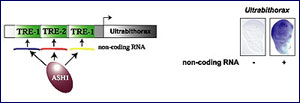UCR Researchers Unlock New Information About How Cells Determine Their Functions

At left is a schematic showing how the Ash1 epigenetic activator interacts with the DNA of the fruit fly drosophila. At right is Ultrabithorax expression in the fruit fly wing.
Biochemistry Professor Frank Sauer and colleagues uncover new information about how embryonic fruit fly cells differentiate, a process that may advance cancer and stem-cell research.
Researchers at the University of California, Riverside have discovered a molecular mechanism that directs the fate and function of cells during animal development. The findings could hold promise for the advancement of cancer and stem-cell research.
The research is published in the Feb. 24 edition of the journal Science. UCR Biochemistry Professor Frank Sauer, with German colleague Elisabeth Kremmer of the Institut für Molekulare Immunologie in Munich, and fellow UCR researchers Tilman Sanchez-Elsner and Dawei Gou authored the paper titled, Noncoding RNAs of Trithorax Response Elements Recruit Dosphila Ash1 to Ultrabithorax.
The paper explains how proteins, known as epigenetic activators (such as Ash1 from the fruit fly Drosophila), bind to their target DNA and activate genes that determine what function a cell will have in the body.
“The fact that these epigenetic activators, such as Ash1, turn on the expression of specific target genes has been known for some time. However, the mechanisms by which epigenetic activators recognize and bind these target genes was not yet known” Sauer pointed out.
“What we were able to show is that the epigenetic activator Ash1is recruited to a target gene through cell-type specific non-coding RNA” he said.
The paper examined how the activator Ash1 binds to target DNA elements, known as Trithorax-reponse elements (TREs), located in the gene Ultrabithorax (Ubx). Non-coding RNA is produced by and retained at the TREs of Ubx, and helps activate the expression of the Ubx gene by attracting Ash1 to the TREs. The transgenic transcription of non-coding TRE RNA can change the type and function of cells.
“As a result, we can now use non-coding RNAs as tools to actively determine cell fate,” Sauer said.
“Over the last few years, researchers have focused on how noncoding RNAs silence genes,” said Anthony Carter, of the National Institute of General Medical Sciences, which partially funded the research. “Dr. Sauer’s work has revealed that noncoding RNAs have a broader range of functions than was previously known, and suggests a model for how they can help activate, rather than silence, a key regulator of animal development.”
The research was funded in part through the National Institute of General Medical Sciences at the National Institutes of Health in Bethesda, Md, the Volkswagen Stiftung of Hannover, Germany, Deutsche Forschungsgenmeinschaft (DFG) Transregio 5 and a Postdoctoral fellowship from the (DFG).
Media Contact
More Information:
http://www.ucr.eduAll latest news from the category: Life Sciences and Chemistry
Articles and reports from the Life Sciences and chemistry area deal with applied and basic research into modern biology, chemistry and human medicine.
Valuable information can be found on a range of life sciences fields including bacteriology, biochemistry, bionics, bioinformatics, biophysics, biotechnology, genetics, geobotany, human biology, marine biology, microbiology, molecular biology, cellular biology, zoology, bioinorganic chemistry, microchemistry and environmental chemistry.
Newest articles

Bringing bio-inspired robots to life
Nebraska researcher Eric Markvicka gets NSF CAREER Award to pursue manufacture of novel materials for soft robotics and stretchable electronics. Engineers are increasingly eager to develop robots that mimic the…

Bella moths use poison to attract mates
Scientists are closer to finding out how. Pyrrolizidine alkaloids are as bitter and toxic as they are hard to pronounce. They’re produced by several different types of plants and are…

AI tool creates ‘synthetic’ images of cells
…for enhanced microscopy analysis. Observing individual cells through microscopes can reveal a range of important cell biological phenomena that frequently play a role in human diseases, but the process of…





















